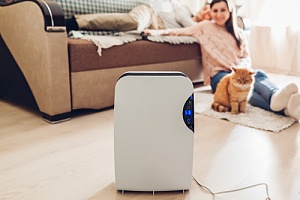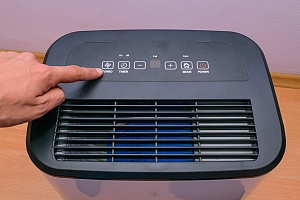Presidential Heating & Air Conditioning
Gaithersburg HVAC Contractors
Share
Share on FacebookTweet
Tweet this0Share
Share on LinkedIn0 shares on LinkedIn Humidity is the amount of water vapor present in the air. The amount of water vapor the air can hold depends on the air temperature. Relative humidity is the ratio of actual vapor in the air to the amount the air can actually hold.
Humidity is the amount of water vapor present in the air. The amount of water vapor the air can hold depends on the air temperature. Relative humidity is the ratio of actual vapor in the air to the amount the air can actually hold.
Achieve Optimal Indoor Humidity Levels with a Dehumidifier
The ability of air to hold water changes as the temperature goes up or down. In general, warmer air can hold more water vapor than cool air. When the relative humidity is 100 percent (as often happens in some areas of the country in the spring and summer), the air is totally saturated with water vapor and cannot hold any more. Outside, this creates the possibility of rain.
The level of humidity, whether outdoors or inside your home, is a big factor in your comfort level. That is because your skin relies on the air to get rid of perspiration. Perspiration is your body’s attempt to keep itself cool. When the air measures at 100 percent relative humidity, your sweat will not evaporate, which interferes with your body’s cooling process.
On the other hand, when the relative humidity is low, you will feel cooler than the actual temperature because your sweat evaporates easily. A humidity level no higher than 50% is best as a general rule of thumb, but the best level indoors depends on the temperature outside.
A dehumidifier is frequently the best solution to lower the humidity to comfortable levels in your home. It will pull moisture from the air before the air conditioner circulates it through your air ducts. When you pair a dehumidifier with an air conditioning system, you can easily adjust the temperature and humidity level of your home.
Other Problems Caused by High Indoor Humidity
Without a dehumidifier in the warmer season, the humidity level in your home can cause a number of issues besides causing discomfort. Excessive indoor humidity is bad because:
- It overburdens your air conditioning system. Your air conditioner cools your home by removing the moisture and heat from the air. The more moisture there is in the air, the harder your air conditioner has to work to achieve a comfortable environment. Sometimes, the humidity levels are simply too high for your air conditioner to handle.
- High humidity fosters the growth of mold and mildew, which triggers allergies and can cause serious health problems for people with mold allergies, sensitive respiratory systems, and asthma.
- It can fog your windows, causing condensation to form and eventually rot your window woodwork.
- High humidity creates an environment that attracts crawling pests such as roaches, spiders, silverfish, and centipedes.
- It can cause moisture stains on your walls and ceilings.
- The humidity can cause wallpaper to peel and paint to blister.
- Wood swells when it absorbs moisture, as evidenced by doors, cabinets or windows getting stuck or your floors creaking. When the wood swells, it can push apart joints and potentially compromise the integrity of the woodwork throughout your home.
How Dehumidifiers Work
Refrigerant: Most dehumidifiers use a refrigerant (i.e., Freon) to pull moisture out of the air. They use four basic parts to pull moisture out of the air.
Fan Compressor – The fan compressor compresses and expands the refrigerant to cool the dehumidifier’s coils.
Reheater — This captures and collects the heat generated by the cooling process.
Compressor cooling coils — Coils filled with the refrigerant.
Reservoir – The reservoir is a container to hold the moisture collected from the air.
The fan draws the air from the room into the dehumidifier. As the air passes into the dehumidifier, it comes into contact with the dehumidifier’s freezing cold cooling coils. The moisture in the air condenses on the coils and becomes water droplets. The droplets drip into the dehumidifier’s reservoir. The reheater then restores the dehumidified air to the original room temperature and blows it back into the room.
When the water reservoir fills up, you will need to empty it manually or make sure the reservoir empties automatically into an appropriate drain.
Desiccant: Desiccant dehumidifiers operate by moisture absorption. A “desiccant” is a substance that reduces humidity by absorbing water molecules. For example, you can reduce humidity in a closet using desiccant packets. Mechanical desiccant dehumidifiers blow air over a desiccant such as silica gel or bentonite clay. These units can only dehumidify a small room.
You can control the dehumidifier and the humidity level with a humidistat. A humidistat works through its two components: a sensing element and a relay amplifier. The sensing element consists of two alternate metal conductors. Changes in relative humidity will cause electrical resistance between those conductors. The relay amplifier measures this resistance and turns the dehumidifier on or off.
What Dehumidifier Works Best for You?
In deciding on the best dehumidifier for your home, you will need to consider the following factors:
Capacity: Capacity refers to how many pints of water the unit will remove from the air in a 24-hour period (pints per day, or ppd) under standard conditions of 80 degrees Fahrenheit and 60% relative humidity (RH). Large capacity models will be rated at 50 – 75 ppd, medium capacity is 45 -50 ppd and small is anything less than 45 ppd.
Efficiency: Units that can remove a larger amount of water per kilowatt hour are more efficient than smaller units. In short, larger dehumidifiers tend to be more efficient than smaller units.
Function: Consider the space you want to dehumidify. You may need a large-capacity “whole-house” dehumidifier that will work with your home’s HVAC system. You may need a dehumidifier specifically for your basement or crawl space. These units are designed to handle the lower-temperature, high moisture conditions found in these environments.
Contact Presidential Heat and Air for More Information
If you are experiencing high levels of humidity in your home, contact the experts at Presidential Heat and Air. They are experienced with controlling indoor humidity levels and can help you find the best dehumidifier for your home and schedule an installation.


